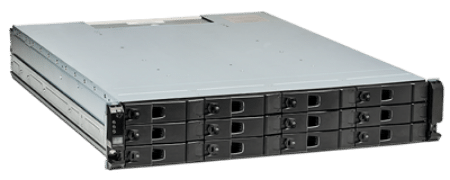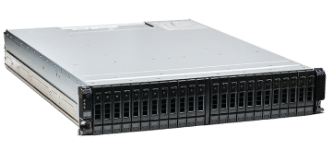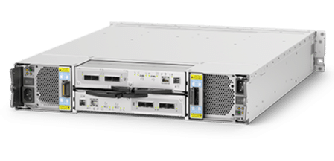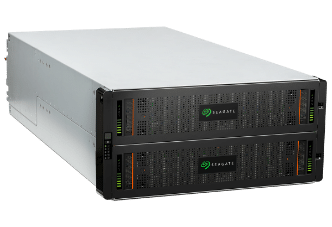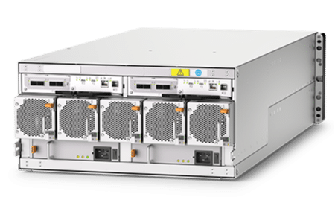Seagate has announced their next generation Exos X Storage Array controllers, the sixth generation in their advanced storage controller series. This new generation offers twice the performance and includes self-healing technology.
Seagate has announced their next generation Exos X Storage Array controllers, the sixth generation in their advanced storage controller series. This new generation offers twice the performance and includes self-healing technology.
The Seagate Exos X Storage Arrays improve performance and reliability for environments that range from small business infrastructures and scaling up to very large, petabyte-scale business infrastructures, with 2U and 5U enclosure options available.
The controllers are built for speed and resilience. They provide reliability and self-healing, as well as ease of setup, maintenance, and expansion. With these next-gen controllers, businesses can scale capacity while maintaining consistently high performance and reliability.
Seagate Exos X Storage Array Configurations
The available storage enclosures for the storage array controllers start with great a entry-level, 12 drive option at 2U of rack space. There is also a mid-range option that provides 24 drives per enclosure at the 2U size, and for greater capacity, there is a 5U enclosure that can hold 84 drives.
The Exos X 2U12 Storage Array enclosure can be expanded to include 10 enclosures maximum, including the master, for a total of 120 drives.
Front view of the Exos X 2U12 Storage Array shelf. The detailed specifications are here.
The Exos X 2U24 Storage Array enclosure can also be expanded to include 10 enclosures maximum, including the master, for a total of 240 drives.
Front view of the Exos X 2U24 Storage Array shelf. The detailed specifications are here.
Back view of the 2U Exos X Storage Array shelf
The Exos X 5U84 Storage Array enclosure can be expanded to include 4 enclosures maximum, including the master, for a total of 336 drives.
Front view of the Exos X 5U84 Storage Array Shelf. The detailed specifications can be found here.
Back view of the 5U Exos X Storage Array Shelf
Key Features of the Seagate Exos X Storage Arrays
The Exos X Storage Array controllers can provide up to 2X the performance of the previous generation by implementing dual redundant, active-active controllers powered by the ASIC-based VelosCT controller architecture. The VelosCT controller enables up to 725,000 IOPS (I/Os per second) with 1ms latency, sequential reads up to 12GB/s, and writes up to 10GB/s.
In addition to superior performance, the Seagate Exos X Storage Array controllers offer enterprise-class reliability capabilities by allowing hot-swap of various components, as well as self-healing storage technology that includes Seagate ADAPT (Advanced Distributed Autonomic Protection Technology), and ADR (Autonomous Drive Regeneration). These design features have been field-proven to provide five nines (99.999%) availability.
The arrays also offer maximum storage flexibility seamlessly, providing SSD, HDD, and hybrid storage configuration options. That flexibility comes with the ability to start small, at 12 drives with a single 2U enclosure, and expand up to 336 drives by configuring a system that contains 4 of the 5U enclosures, at 84 drives each.
Each of these Seagate Exos X Storage Arrays provides 4 host ports per controller, and 8 per system, utilizing SFP+/SFP28 or mini-SAS HD port options. As well, this new generation of storage arrays have options for host interfaces that can be 32/16Gb FC, 25/10GbE iSCSI, 10GBASE-T Auto to 1Gb, or 12Gb SAS connectivity.
As previously mentioned, these controllers provide data protection through improved Seagate ADAPT (Advanced Distributed Autonomic Protection Technology). This data protection is available in various drive configurations, including NRAID (aka JBOD), as well as RAID 0, 1, 5, 6, and 10.
The data protection features are even further enhanced with High Availability features that include dual-redundant hot-swappable components (controllers, drives, fans, power supplies, power cords), Seagate’s ADR (Autonomous Drive Regeneration), hot standby spare, automatic failover, and multi-path support.
More advanced features are also available in the Exos X Storage arrays, such as virtual pools, thin provisioning, SSD read cache, encryption, auto-tiering, snapshots, and asynchronous replication.
For manageability, the Exos X systems also provide support for the Redfish and Swordfish open standard management protocols, allowing for integrated management tool capabilities.
Broad Industry Use
We see the Seagate controllers leveraged by OEMs frequently, so it’s exciting to see new features and performance benefits hitting these models. Both Dell, with their PowerVault ME4 and ME5 storage arrays, as well as HPE, with their MSA lines, leverage the platform (formerly Dot Hill). So even if you don’t buy the branded Seagate controller directly, many of these benefits trickle down to products many vendors leverage.
While we have not evaluated these Exos configurations under the Seagate flag as of yet, historically we’ve seen fantastic performance and a robust feature set from these controllers. They’re some of the best around for entry and midmarket needs, which is why Dell and HPE prefer to white label them.
Engage with StorageReview
Newsletter | YouTube | Podcast iTunes/Spotify | Instagram | Twitter | TikTok | RSS Feed

